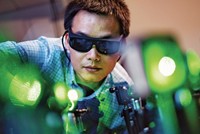Advertisement
Grab your lab coat. Let's get started
Welcome!
Welcome!
Create an account below to get 6 C&EN articles per month, receive newsletters and more - all free.
It seems this is your first time logging in online. Please enter the following information to continue.
As an ACS member you automatically get access to this site. All we need is few more details to create your reading experience.
Not you? Sign in with a different account.
Not you? Sign in with a different account.
ERROR 1
ERROR 1
ERROR 2
ERROR 2
ERROR 2
ERROR 2
ERROR 2
Password and Confirm password must match.
If you have an ACS member number, please enter it here so we can link this account to your membership. (optional)
ERROR 2
ACS values your privacy. By submitting your information, you are gaining access to C&EN and subscribing to our weekly newsletter. We use the information you provide to make your reading experience better, and we will never sell your data to third party members.
Synthesis
Detecting DNA-binding agents visually
February 27, 2006
| A version of this story appeared in
Volume 84, Issue 9
A convenient colorimetric assay that could be used to screen drug candidates on the basis of how strongly they bind DNA has been developed by Chad A. Mirkin's group at Northwestern University (Angew. Chem. Int. Ed., published online Feb. 15, dx.doi.org/10.1002/anie.200504277). "This could dramatically speed up the identification of new anticancer agents," Mirkin says. The assay uses gold nanoparticles that have been functionalized with one of two complementary oligonucleotides. When the particles are mixed, the complementary strands hybridize, thereby forming particle aggregates that appear blue. Heating the mixture above a critical temperature reverses the process, and the particles dissociate with a concomitant blue-to-red color change (shown). If the two varieties of nanoparticles are mixed in the presence of a drug candidate that binds to duplex DNA, the duplexes formed between the particles will be more stable than ordinary duplexes, and it will require a higher temperature to dehybridize them and dissociate the aggregates. By visually monitoring the blue-to-red transition temperature, the researchers can determine how strongly or weakly a drug candidate binds to DNA to get an indication of its biological activity.





Join the conversation
Contact the reporter
Submit a Letter to the Editor for publication
Engage with us on Twitter